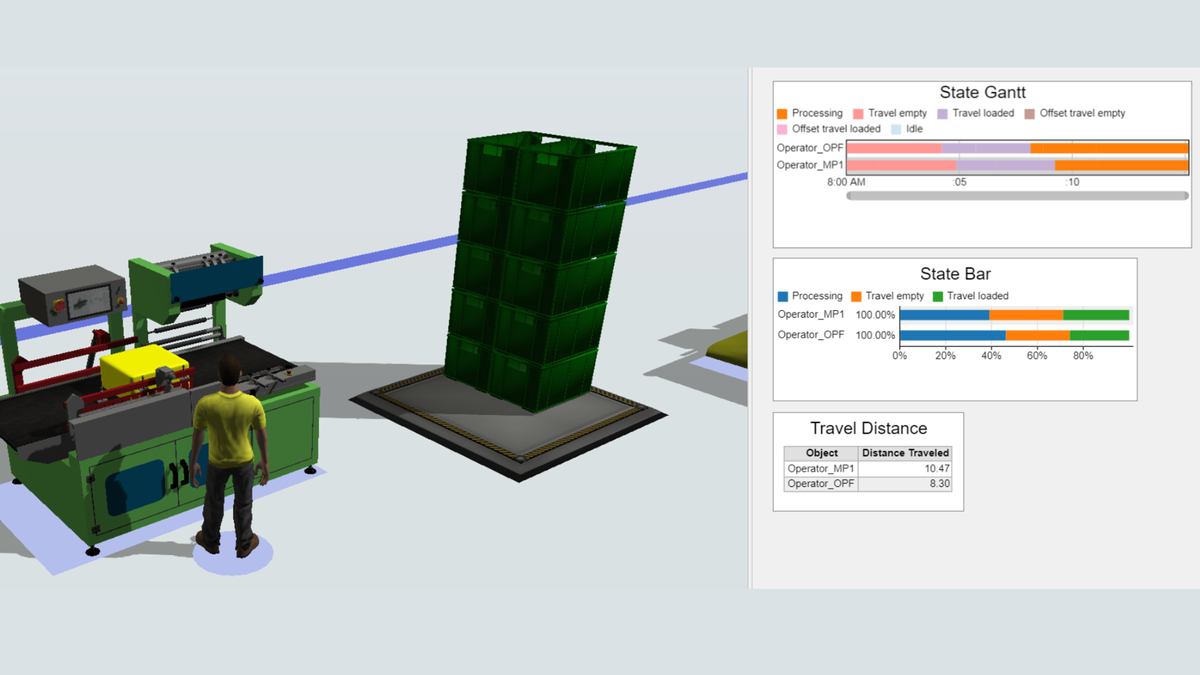Enhancing Manufacturing Efficiency: The Role of Simulation in One-Piece Flow Analysis
In this blog post, I will thoroughly explore how simulation, mainly using the advanced capabilities of FlexSim, plays a pivotal role in analyzing and optimizing one-piece flow within manufacturing environments.

In today's rapidly evolving manufacturing landscape, pursuing operational excellence, waste minimization, and enhanced productivity is an ongoing endeavor. A method that has garnered considerable attention in driving toward these targets is the principle of one-piece flow, also known as single-piece or continuous flow. This lean manufacturing concept emphasizes the seamless and uninterrupted production of items one at a time instead of in batches.
In this blog post, I will thoroughly explore how simulation, mainly using the advanced capabilities of FlexSim, plays a pivotal role in analyzing and optimizing one-piece flow within manufacturing environments. By dissecting the intricate workflows and processes involved in the one-piece flow, I aim to shed light on how simulation technology can be leveraged to refine and enhance operational efficiency, reduce waste, and ultimately elevate productivity within manufacturing operations.
Understanding One-Piece Flow
One-piece flow is a production methodology that emphasizes the continuous movement of a single product through each step of the manufacturing process without delays, interruptions, or queues. This approach contrasts with traditional batch processing, in which multiple items are processed at each stage before advancing to the next.
Adopting a one-piece flow offers many benefits. It helps minimize waste, both in terms of time and resources, by eliminating overproduction and excess inventory. This approach also enhances quality control by immediately identifying and rectifying defects. Furthermore, one-piece flow reduces lead times, making the production process more efficient and responsive to customer demand.
The Role of Simulation in Manufacturing
Simulation has proven crucial in modern manufacturing, offering valuable insights into process efficiencies and identifying potential bottlenecks. By crafting a virtual manufacturing process model, companies can rigorously test various scenarios, forecast likely outcomes, and derive informed decisions, all without disrupting actual production.
FlexSim: A Powerful Tool for One-Piece Flow Analysis
FlexSim is an advanced 3D simulation software specifically engineered to accurately model, analyze, and optimize any process or system. Its remarkable capability lies in its ability to simulate intricate manufacturing environments and processes. When utilized for one-piece flow analysis, FlexSim delivers a range of significant advantages:
- Visualizing the Process: the 3D modeling capabilities allow for a detailed and realistic visualization of the manufacturing process. This visualization aids in understanding how a product moves through each stage and identifies potential issues, such as bottlenecks or unnecessary steps.
- Identifying Bottlenecks: one of the challenges in implementing a one-piece flow is identifying and addressing bottlenecks. Simulation lets manufacturers pinpoint exactly where delays occur and why, allowing for targeted improvements.
- Testing Different Scenarios: manufacturers can experiment with different layouts, processes, and workflows to find the most efficient way to implement a one-piece flow. This includes adjusting the positioning of equipment, changing staff assignments, or modifying the sequence of operations.
- Quantifying Impact: simulation helps visualize and identify issues and quantifies the impact of changes. It provides data on key metrics like throughput, cycle time, and utilization, which are critical in assessing the effectiveness of one-piece flow.
- Continuous Improvement: lean manufacturing is all about continuous improvement, and simulation supports this by allowing for ongoing refinement and optimization of the one-piece flow process. As real-world conditions change, simulation can be used to adjust and improve the process accordingly.

Implementing One-Piece Flow with FlexSim
The implementation of a one-piece flow using FlexSim typically involves several steps:
- Model Creation: The first step is to create a detailed model of the current manufacturing process within FlexSim. This model includes all relevant aspects of the production line, from machinery and workforce to workflows and policies.
- Baseline Simulation: Run simulations to establish a baseline, understand how the current batch process operates, and identify inefficiencies and waste.
- Process Redesign: Use FlexSim to redesign the process for a one-piece flow. This might involve reconfiguring the layout, reassigning tasks, or changing the sequence of operations.
- Scenario Testing: Run multiple simulations with different variables to determine the most efficient one-piece flow process. Analyze results for each scenario and select the optimal configuration.
- Implementation and Monitoring: Implement the chosen one-piece flow process in the real world, using FlexSim to continually monitor and refine the process.

Conclusion
Implementing a one-piece flow in manufacturing can significantly improve efficiency, productivity, and overall operational performance. One-piece flow is a lean manufacturing concept that focuses on producing one item at a time, thereby reducing lead times, minimizing inventory, and increasing flexibility in responding to customer demand.
FlexSim is an advanced simulation software that offers essential tools for analyzing, testing, and optimizing manufacturing processes. This allows organizations to make informed decisions and design efficient production systems.
Using simulation, manufacturers can visualize the effects of transitioning to a one-piece flow system, identify potential bottlenecks, optimize resource allocation, and mitigate risks before implementing changes in the production environment.
By utilizing advanced simulation features, manufacturers can ensure a smooth transition to a one-piece flow system, resulting in practical, tangible outcomes that align with the theoretical benefits of this lean manufacturing approach.
If you found this article interesting and useful, please subscribe to learn more about our situational problem-solving and simulation services.




